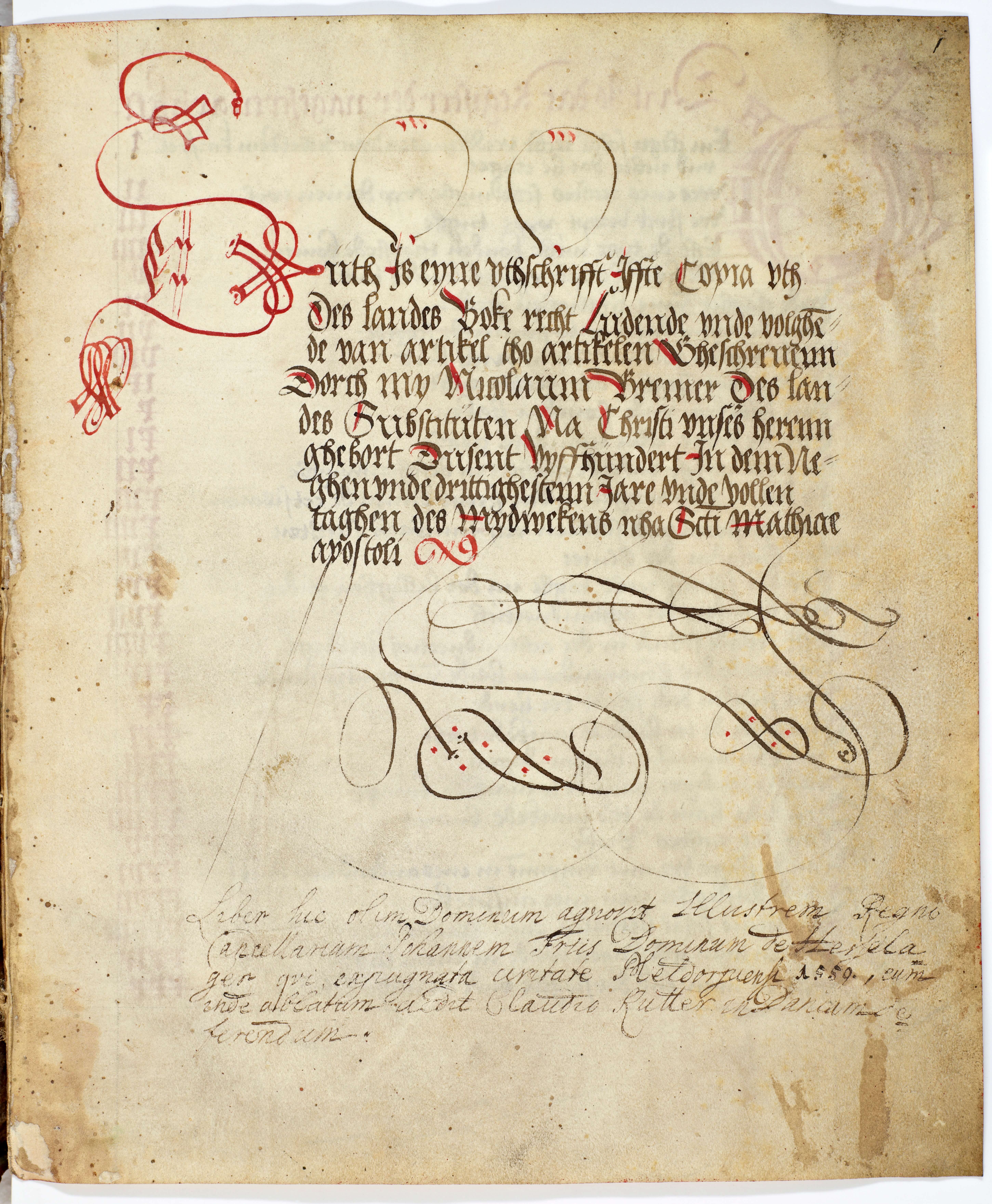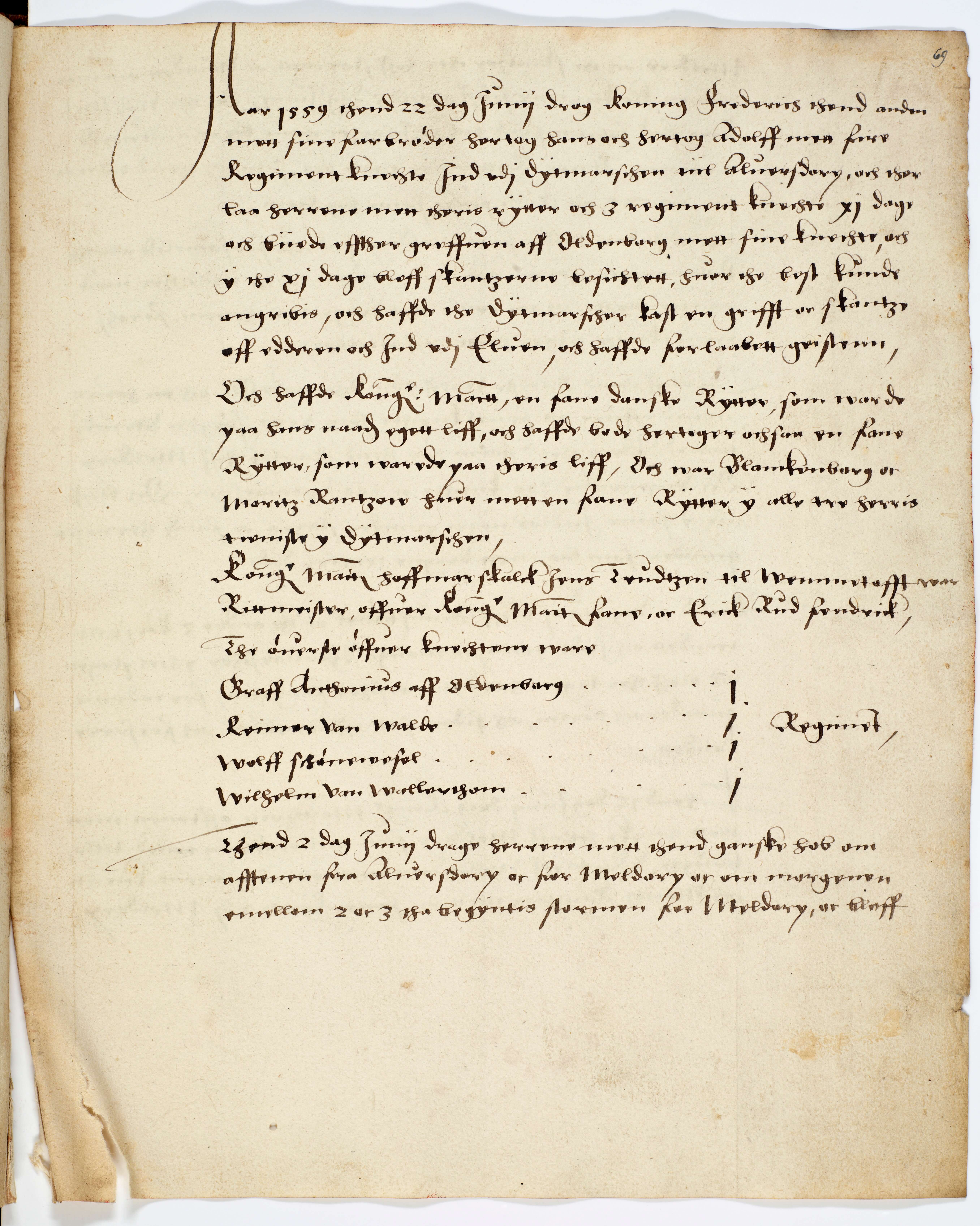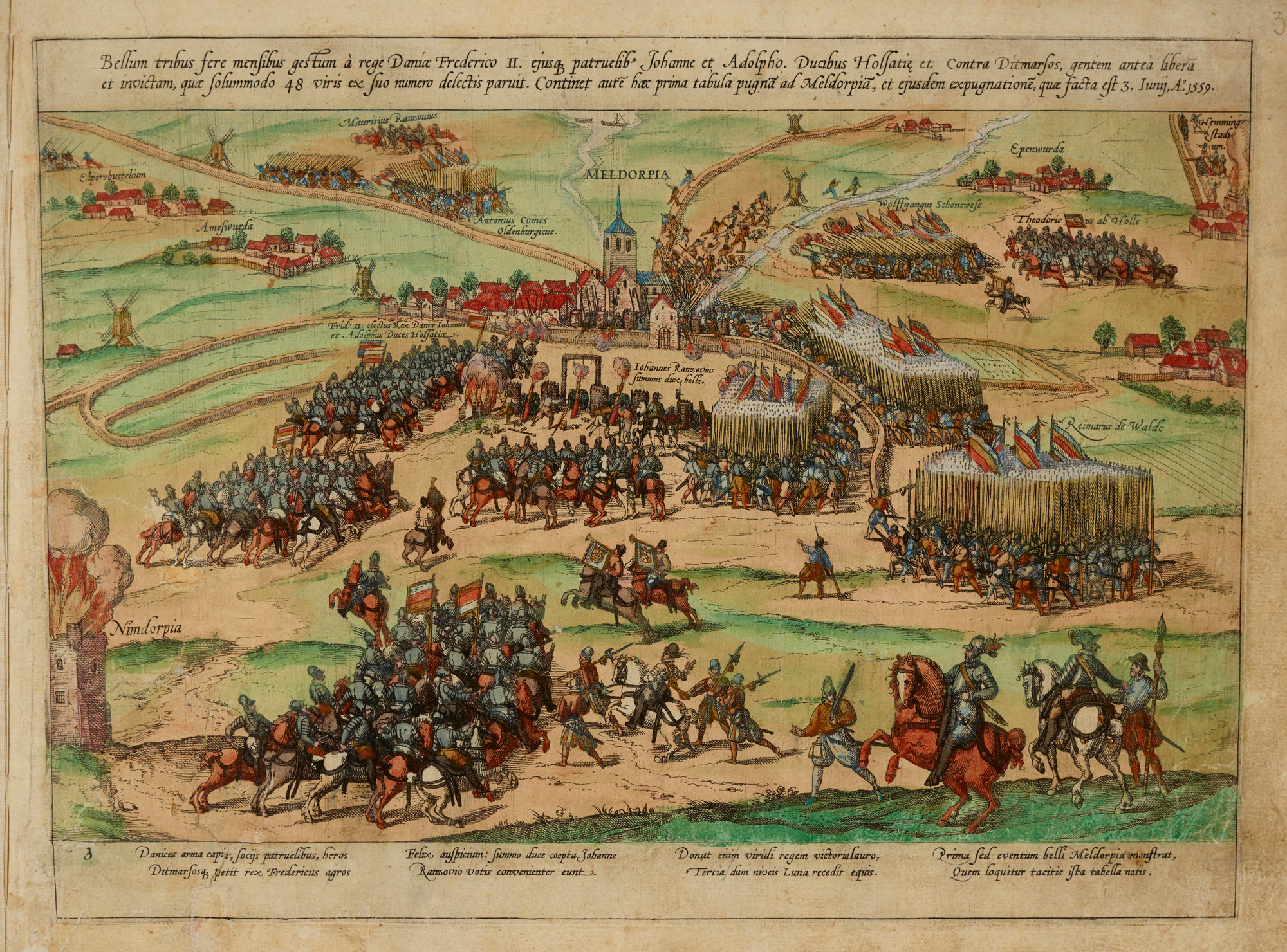The Danish Conquest of Dithmarschen
The Low German law codex AM 2 4to contains the younger redaction of the Land Law of Dithmarschen. A later addition in Danish describes the conquest of Dithmarschen by the Kingdom of Denmark in 1559.

The ‘Peasant Republic’ of Dithmarschen
Dithmarschen is a geographic region by the North Sea between the rivers Eider and Elbe in modern Germany. Medieval Dithmarschen is often referred to as an independent ‘peasant republic’ (German: freie Bauernrepublik). Strictly speaking, it was neither independent nor a republic, but rather a highly autonomous territory within the Holy Roman Empire. After the battle of Bornhöved in 1227, Dithmarschen formally came under the sovereignty of the Prince-Archbishopric of Hamburg-Bremen. In practice, however, the prince-archbishops did not carry out their executive powers; the legal and religious administration of Dithmarschen was instead managed by the peasants themselves.

During the Middle Ages, Dithmarschen became a very wealthy region which caused the rulers of the neighbouring territories to repeatedly try to conquer it. In 1500, an army counting 12000 men invaded Dithmarschen on the behest of King John of Denmark and his bother Frederick (later King Frederick I). The two brothers were co-dukes of the disputed territories Schleswig and Holstein, which border Ditmarschen.
In Battle of Hemmingstedt on 17 February 1500, however, the peasants of Dithmarschen, who counted only a few thousand men led by Wulf Isebrand (†1506), defeated the numerically superior invading army and defended their legal and religious autonomy for another half century.
The Land Law of Dithmarschen
Like many regions in medieval Northern Europe, Dithmarschen had its own ‘Land law’, based on generally accepted legal customs and conventions. In 1447, these legal customs were written down in Low German and codified in the ‘Land Law of Dithmarschen’ (Dithmarscher Landrecht). This first redaction of the law survives in one single manuscript (Copenhagen, Royal Danish Library, Thott 2065 4to); two further manuscripts have been lost.
A second redaction of the law, the so-called ‘Second Land Law of Dithmarschen’ (Zweites Dithmarscher Landrecht), was compiled between 1467 and 1480. The second redaction of the law was first printed by the printer Steffen Arndes in Lübeck (or possibly Schleswig) in either 1487 or 1488. However, only fragments of the first print survive today, held in libraries in Hamburg and Kiel. The second redaction was printed again by the printer Johann Balhorn in Lübeck in 1539. Besides the printed exemplars, two manuscripts preserve the second redaction of the Land Law; a third manuscript has been lost.
AM 2 4to is one of these two surviving manuscripts. This composite codex consists partly of parchment (ff. 1–52), partly of paper (ff. 53–73). The first part (ff. 1r-50r) contains the second Land Law of Dithmarschen in Low German, followed by several minor legal provisions and administrative notes. A later addition on ff. 69r–71r is written in Danish and describes the conquest of Dithmarschen by the Kingdom of Denmark in 1559.

Beginning of the Zweites Ditmarscher Landrecht. The text reads: Düth Is eyne vtschrifft Iffte Copia vth Des Landes Boke recht Ludende vnde volghende van artikel tho artikelen Gheschreuenn Dorch my Nicolaum Bremer Des Landes Substituten Na Christi vnses herennghebort Dusent Vyffhundert In dem Neghen vnde drittighestenn Jare unde vollen taghen des Mydwekens nha Scti Mathiae apostoli (’This is a transcript or copy of the book of the land, faithful and accurate, article by article, written by Nicolaus Bremer, deputy of the land, in the year thousand five hundred and thirty-nine after the birth of Christ our Lord and proclaimed on Wednesday after the day of St Matthew the Apostle [i.e. 24 September 1539]’) (AM 2 4to, f. 1r. Image: Suzanne Reitz.)
The ‘Last Feud’
Dithmarschen was finally conquered by the king of Denmark and his allies in 1559 during the so-called ‘Last Feud’ (German: Letzte Fehde).
Aar 1559 thend 22 dag Maij drog koning Frederich thend anden mett sine farbroder hertog Hans och hertog Adolff mett fire regiment knechte jnd vdj Dytmarschen tiil Aluersdorp (f. 69r)
Frederik II, king of Denmark-Norway, joined forces with his two uncles Adolf I and John the Elder to conquer Dithmarschen. Their joint army counted 18000 men and was led by Johann Rantzau (1492–1565), the general for the Danish king who was widely renowned for his strategical mind.
The manuscript AM 2 4to contains a detailed description of the conquest on ff. 69r–71r. It begins: "In the year 1559, on the 22 day of May, King Frederik II set out with his uncles, duke John and duke Adolf, with four regiments of soldiers into Dithmarschen towards Albersdorf."

Thend 2 dag Junij droge herrene mett thend ganske hob om afttenen fra Aluersdorp oc for Meldorp oc om morgenen emellom 2 oc 3 tha begyntis stormen for Meldorp, oc bleff Meldorp och the skantzer ther hoss stormett oc wundet om morgenen klocken war siuff thend 3 dag Junij (f. 69r–v)
The army stayed at Albersdorf for several days to scout the terrain and the peasants’ defences before leaving for Meldorf on 2 June: "On the second day of June, the noblemen set out with the whole host in the evening from Albersdorf towards Meldorf and, in the morning between the second and third, the assault at Meldof began. And Meldorf and the sconces there were assaulted and conquered in the morning, at seven o´clock, the third day of June."

The Battle at Meldorf (1589). Source: Wikimedia Commons
Thend tid the Dytmarscher fornome att wj ware for Heiden tha forlode the Hemmigstede oc droge tiil Heidenn mett theris ganske magtt, Och ther skede enn stor skarmützel, och bleffue mere end 3000 Dytmarscher døde, och mange flyde jnd wdj byen och werede thenom ther saa wy motte sette jld paa Byenn, och bleff Heiden saa aldelis affbrend (f. 70r)
The battles between the invading and defending armies continued until the deciding battle which happened at Heide on 13 June: "When the men of Dithmarschen learned that we were outside Heide, they left Hemmingstedt and set out for Heide with their whole force, and a great battle ensued, and more than 3000 men of Dithmarschen died, and many stormed into the town and ravaged there so that we needed to set fire to the city. And Heide was completely burnt down."

The Battle at Heide (1589). Source: Wikimedia Commons
After the Battle at Heide, the peasants of Dithmarschen sued for peace. The Last Feud ended on 20 June 1559 with the capitulation and subordination of the once free peasants of Dithmarschen.
Bringing the Law North
The description of the conquest in AM 2 4to was written by Klaus Rytter who later became Mayor of Copenhagen from 1584 to his death in 1589. Rytter brought the codex to Denmark at request of his master, Johan Friis of Hesselager, a Danish nobleman and chancellor under Christian III, who had acquired the codex in Meldorf after the battle on 3 June: "And there in Meldorf, Johann Friss of Hesselager acquired this book and he handed this book to me, Klaus Rytter, who was at that time his servant, to bring the same book home."
Och ther wdj Meldorp feck Johann friss tiil hesselagger thene bog och andtuorde hand meg Claws Rytter ther thene bog, som ieg thend tid war sin tienere, att skulle förre same bog hiem (f. 69v)
Johan Friis was a learned man who had studied in Odense, Copenhagen, Cologne and Rome and received the title of magister. It is therefore not surprising that he would have been interested in a legal codex containing the laws of Dithmarschen. Rare and valuable books have been popular spoils of war throughout human history. However, acquiring AM 2 4to and taking it to Denmark may also have had a practical purpose.

In the aftermath of the conquest, Dithmarschen was first divided by the three dukes into three parts, and later into two when John the Elder died in 1580 without an heir and his territories were divided between brother and nephew. In this reorganisation of Dithmarschen, the Duke of Schleswig-Holstein-Gottorf received sovereignty over Northern Dithmarschen while the King of Denmark received sovereignty over Southern Dithmarschen. The chancellery in Copenhagen would thus have needed to know the law of the newly-annexed territory to execute their legal and administrative responsibilities.
A revised third redaction of the Land Law of Dithmarschen was compiled in 1567 by Adam Tratziger (1523–1584), chancellor of the ducal parts of Schleswig and Holstein, and Heinrich Rantzau (1526–1598), son of Johann Rantzau and governor of the Royal Danish parts of Schleswig and Holstein. This third redaction was printed by Melchior Koch in Glückstadt in 1667 and again by Gotthilf Lehmann in Glückstadt in 1711. The third redaction of the Land Law of Dithmarschen remained in force until 1900, when it was eventually replaced by the common German Bürgerliches Gesetzbuch.
AM 2 4to and the Arnamagnæan Collection
Once the codex was brought to Denmark, it remained there until today. In the eighteenth century, it was part of the private book collection of Federik Rostgaard (1671–1745) who was archivist of the Danish king’s privy archives. After Rostgaard’s death, his successor Árni Magnússon acquired the codex at the auction of Rostgaard’s books for the Royal Danish Library as he considered it to be ‘superior’ to the printed redaction of the law (Håndskriftfortegnelser, xix). However, the codex never made it into the Royal Danish Library. Instead it became part of the Arnamagnæan Collection, where it is still kept today.
Topics
Contact
 Tom Lorenz is a Ph.D. candidate at the Norwegian University of Science and Technology in Trondheim.
Tom Lorenz is a Ph.D. candidate at the Norwegian University of Science and Technology in Trondheim.
Bibliography
Arne Magnussons I AM. 435 a-b, 4to indeholdte Håndskriftfortegnelser. Med to tillæg. Udgivne af Kommissionen for Der Arnamagnæanske Legat. København 1909.
Kålund, Kristian. 1888–1894. Katalog over den Arnamagnæanske håndskriftsamling. København.
Mißfeldt, Jörg. 2021. Norderdithmarschen im dänischen Gesamtstaat (1773–1864). Kiel.
Oppitz, Ulrich-Dieter. 2004. “Dithmarscher Landrech” Die deutsche Literatur des Mittelalters. Verfasserlexikon. Second edition. Vol. 11. Berlin/New York, 370-372.
Rørdam, Holger Frederik (ed.). 1885. “En kort Beretning om Ditmarskens Erobring 1559. Af Klavs Rytter, Kansler Johan Friis’s Tjener. Monumenta historiæ danicæ. historiske kildeskrifter og bearbejdelser af dansk historie især fra det 16. Aarhundrede. 2 vols. Kjøbenhavn, 563–570.
Contribute to Manuscript of the Month
Have something to say about one or more manuscripts in the Arnamagnæn Collection? Contribute to the column Manuscript of the Month to get your research out there! Write to Seán Vrieland (sean.vrieland@hum.ku.dk) for more details.
